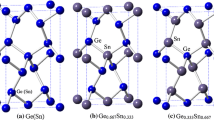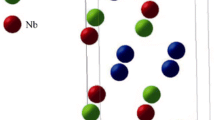Abstract
The objective of this research is to look at how anisotropic mechanical stresses affect the structural, elastic, and electronic properties of various GaSe polytypes. Density functional theory (DFT) was employed in all calculations. Consistent and precise calculations as well as descriptions of trade-off and correlation effects were performed using the LDA-PBE approximation. The uni-axial compressive stresses in the GaSe layer planes, in addition to the perpendicularly applied uni-axial compressive stress, are taken into account (along the c-axis). The gap distance and the \(\widehat{Ga Ga Se}\) bond angle, both of which determine the thickness of crystal layers and the size of the unit cell in the basal plane, have the largest influence on changes in the lattice parameters a and c. Compression along the c-axis causes the interlayer spacing to shrink and the crystal anisotropy to decrease, whereas compression in the layer planes has no effect on gallium selenide’s property. The stability conditions reflect that the different polytypes of GaSe are mechanically stable at zero pressure and under pressure. Our results at zero pressure show that the B/G ratio is of order of 1.33, 1.44, 1.67, and 1.44 for ε-GaSe, β-GaSe, γ-GaSe, and δ-GaSe, respectively, which means that all polytypes GaSe crystal are fragile. The calculated band structure shows that the structure semiconductors ε-GaSe, β-GaSe, and δ-GaSe have a direct band gap of 0.751 eV, 0.818 eV, and 0.888 eV respectively and an indirect band gap of 0.819 eV for γ- GaSe. At bi-axial strains up to 8 GPa, calculations of the electronic band structure demonstrate a progressive growth in the band gap. Inter-band transition energy appears to be decreasing with loading under uni-axial compressive stress along the c-axis. A transition to the metallic type of conductivity may occur when the projected pressure dependences of the direct and indirect band gaps are taken into account at uni-axial pressures of roughly 10 GPa.












Similar content being viewed by others
References
Bassou A, Rajira A, El Kanouny A et al (2020) Optical properties of GaSe, characterization and simulation. Mater Today: Proc 37:3789–3792. https://doi.org/10.1016/j.matpr.2020.07.622
Van Lare C, Yin G, Polman A, Schmid M (2015) Light coupling and trap** in ultrathin Cu(In, Ga)Se2 solar cells using dielectric scattering patterns. ACS Nano 9:9603–9613. https://doi.org/10.1021/acsnano.5b04091
Movla H (2014) Optimization of the CIGS based thin film solar cells: numerical simulation and analysis. Optik 125:67–70. https://doi.org/10.1016/j.ijleo.2013.06.034
Mostefaoui M, Mazari H, Khelifi S et al (2015) Simulation of high efficiency CIGS solar cells with SCAPS-1D software. Energy Procedia 74:736–744. https://doi.org/10.1016/j.egypro.2015.07.809
Al-Hattab M, Moudou L, Khenfouch M et al (2021) Numerical simulation of a new heterostructure CIGS/GaSe solar cell system using SCAPS-1D software. Sol Energy 227:13–22. https://doi.org/10.1016/j.solener.2021.08.084
Eckhoff WC, Putnam RS, Wang S et al (1996) A continuously tunable long-wavelength cw IR source for high-resolution spectroscopy and trace-gas detection. Appl Phys B: Lasers Opt 63:437–441. https://doi.org/10.1007/s003400050106
Ku SA, Chu W-C, Luo CW et al (2012) Optimal Te-do** in GaSe for non-linear applications. Opt Express 20:5029. https://doi.org/10.1364/oe.20.005029
Kyazym-Zade AG, Agaeva AA, Salmanov VM, Mokhtari AG (2007) Optical detectors on GaSe and InSe layered crystals. Tech Phys 52:1611–1613. https://doi.org/10.1134/S1063784207120146
Castellano A (1986) GaSe detectors for x-ray beams. Appl Phys Lett 48:298–299. https://doi.org/10.1063/1.96586
Liu K, Xu J, Zhang XC (2004) GaSe crystals for broadband terahertz wave detection. Appl Phys Lett 85:863–865. https://doi.org/10.1063/1.1779959
Chen C-W, Tang T-T, Lin S-H et al (2009) Optical properties and potential applications of ɛ-GaSe at terahertz frequencies. J Opt Soc Am B 26:A58. https://doi.org/10.1364/josab.26.000a58
Seyhan A, Karabulut O, Akmoǧlu BG et al (2005) Optical anisotropy in GaSe. Cryst Res Technol 40:893–895. https://doi.org/10.1002/crat.200410452
Allakhverdiev KR, Yetis MÖ, Özbek S et al (2009) Effective nonlinear GaSe crystal. Optical properties and applications Laser Physics 19:1092–1104. https://doi.org/10.1134/s1054660x09050375
Forney JJ, Maschke K, Mooser E (1977) Influence of stacking disorder on Wannier excitons in layered semiconductors. J Phys C: Solid State Phys 10:1887–1894. https://doi.org/10.1088/0022-3719/10/11/023
Lim SY, Lee JU, Kim JH et al (2020) Polytypism in few-layer gallium selenide. Nanoscale 12:8563–8573. https://doi.org/10.1039/d0nr00165a
Allakhverdiev K, Baykara T, Ellialtioǧlu Ş et al (2006) Lattice vibrations of pure and doped GaSe. Mater Res Bull 41:751–763. https://doi.org/10.1016/j.materresbull.2005.10.015
Al-Hattab M, Moudou L, Chrafih Y et al (2020) The anisotropic optical properties of different polytypes ( ε, β, δ, γ ) of GaSe lamellar materials. Eur Phys J Appl Phys 91:30102. https://doi.org/10.1051/epjap/2020200136
Kuhn A, Chevy A, Chevalier R (1975) Crystal structure and interatomic distances in GaSe. Physica Status Solidi (a) 31:469–475. https://doi.org/10.1002/pssa.2210310216
Segall MD, Lindan PJD, Probert MJ et al (2002) First-principles simulation: ideas, illustrations and the CASTEP code. J Phys: Condens Matter 14:2717–2744. https://doi.org/10.1088/0953-8984/14/11/301
Perdew JP, Wang Y (2018) Accurate and simple analytic representation of the electron-gas correlation energy. Phys Rev B 98:244–249. https://doi.org/10.1103/PhysRevB.98.079904
Camara MOD, Mauger A, Devos I (2002) Electronic structure of the layer compounds GaSe and InSe in a tight-binding approach. Phys Rev B - Condens Matter Mater Phys 65:1–12. https://doi.org/10.1103/PhysRevB.65.125206
De Blasi C, Manno D, Rizzo A (1989) Convergent-beam electron diffraction study of melt-and vapour-grown single crystals of gallium chalcogenides. Il Nuovo Cimento D 11:1145–1163. https://doi.org/10.1007/BF02459022
Ghalouci L, Benbahi B, Hiadsi S et al (2013) First principle investigation into hexagonal and cubic structures of gallium selenide. Comput Mater Sci 67:73–82. https://doi.org/10.1016/j.commatsci.2012.08.034
Cenzual K, Gelato LM, Penzo M, Parthé E (1991) Inorganic structure types with revised space groups. I Acta Crystallographica Section B 47:433–439. https://doi.org/10.1107/S0108768191000903
Kaminskii VM, Kovalyuk ZD, Pyrlya MN et al (2005) Properties of hydrogenated GaSe crystals. Inorg Mater 41:793–795. https://doi.org/10.1007/s10789-005-0212-z
Adler C, Honke R, Pavone P, Schröder U (1998) First-principles investigation of the lattice dynamics of e-GaSe. Phys Rev B - Condens Matter Mater Phys 57:3726–3728. https://doi.org/10.1103/PhysRevB.57.3726
Srour J, Badawi M, El Haj Hassan F, Postnikov AV (2016) Crystal structure and energy bands of (Ga/In)Se and Cu(In,Ga)Se2 semiconductors in comparison. Physica Status Solidi (B) Basic Res 253:1472–1475. https://doi.org/10.1002/pssb.201552776
Jeliinek F, Hahn H (1961) Zur polytypie des galliummonoselenids, gase. Zeitschrift fur Naturforschung - Section B J Chem Sci 16:713–715. https://doi.org/10.1515/znb-1961-1102
Benazeth S, Dung NH, Guittard M, Laruelle P (1988) Affinement sur monocristal de la structure du polytype 2H du séléniure de gallium GaSe forme β. Acta Crystallogr C 44:234–236. https://doi.org/10.1107/s0108270187010102
Srour JY (2016) Electronic structure and competition of phases in Cu- ( In , Ga ) -Se , Ga-Se and In-Se semiconductors : first-principles calculations based on different exchange-correlation potentials. Doctoral thesis University of Lorraine
Bassani F, Parravicini GP (1967) Band structure and optical properties of graphite and of the layer compounds GaS and GaSe. Il Nuovo Cimento B Series 10(50):95–128. https://doi.org/10.1007/BF02710685
Kosobutsky AV, Sarkisov SY, Brudnyi VN (2013) Structural, elastic and electronic properties of GaSe under biaxial and uniaxial compressive stress. J Phys Chem Solids 74:1240–1248. https://doi.org/10.1016/j.jpcs.2013.03.025
Robertson J (1979) Electronic structure of GaSe, GaS, InSe and GaTe. J Phys C: Solid State Phys 12:4777–4789. https://doi.org/10.1088/0022-3719/12/22/019
Depeursinge Y (1981) Electronic properties of the layer III-VI semiconductors. A comparative study. Il Nuovo Cimento B Series 11 64:111–150. https://doi.org/10.1007/BF02721299
Nagel S, Baldereschi A, Maschke K (1979) Tight-binding study of the electronic states in GaSe polytypes. J Phys C: Solid State Phys 12:1625–1639. https://doi.org/10.1088/0022-3719/12/9/006
Schwarz U, Olguin D, Cantarero A et al (2007) Effect of pressure on the structural properties and electronic band structure of GaSe. Physica Status Solidi (B) Basic Res 244:244–255. https://doi.org/10.1002/pssb.200672551
Rak Z, Mahanti SD, Mandal KC, Fernelius NC (2009) Electronic structure of substitutional defects and vacancies in GaSe. J Phys Chem Solids 70:344–355. https://doi.org/10.1016/j.jpcs.2008.10.022
Aulich E, Brebner JL, Mooser E (1969) Indirect energy gap in GaSe and GaS. Physica Status Solidi (B) 31:129–131. https://doi.org/10.1002/pssb.19690310115
McCanny JV, Murray RB (1977) The band structures of gallium and indium selenide. J Phys C: Solid State Phys 10:1211–1222. https://doi.org/10.1088/0022-3719/10/8/022
Wu ZJ, Zhao EJ, **ang HP et al (2007) Crystal structures and elastic properties of superhard Ir N2 and Ir N3 from first principles. Phys Rev B - Condens Matter Mater Phys 76:1–15. https://doi.org/10.1103/PhysRevB.76.054115
Nyawere PWO, Makau NW, Amolo GO (2014) First-principles calculations of the elastic constants of the cubic, orthorhombic and hexagonal phases of BaF2. Physica B 434:122–128. https://doi.org/10.1016/j.physb.2013.10.051
Balyts’kyi OO (2003) Degradation and fracture of crystals of gallium and indium selenides. Mater Sci 39:561–565. https://doi.org/10.1023/B:MASC.0000010935.25675.e8
Zhang SR, Zhu SF, Zhao BJ et al (2014) First-principles study of the elastic, electronic and optical properties of ε-GaSe layered semiconductor. Physica B 436:188–192. https://doi.org/10.1016/j.physb.2013.12.014
Rak Z, Mahanti SD, Mandal KC, Fernelius NC (2010) Do** dependence of electronic and mechanical properties of GaSe 1-xTex and Ga1-xInxSe from first principles. Phys Rev B - Condens Matter Mater Phys 82:1–10. https://doi.org/10.1103/PhysRevB.82.155203
Chiang TC, Dumas J, Shen YR (1978) Brillouin scattering in the layer compound GaSe. Solid State Commun 28:173–176. https://doi.org/10.1016/0038-1098(78)90049-2
Yasuaki H, Masayoshi Y, YamamotoAbe KK (1983) Elastic constants of GaS and GaSe layered crystals determined by Brillouin scattering. J Phys Soc Jpn 52:2777–2783
Cui S, Feng W, Hu H et al (2011) Effect of high hydrostatic pressure on structural stability of Ti 3GeC2: a first-principles investigation. J Solid State Chem 184:786–789. https://doi.org/10.1016/j.jssc.2011.02.007
Goldstein RV, Gorodtsov VA, Lisovenko DS (2016) The elastic properties of hexagonal auxetics under pressure. Physica Status Solidi (B) Basic Res 253:1261–1269. https://doi.org/10.1002/pssb.201600054
Zeng X, Peng R, Yu Y, et al (2018) Pressure effect on elastic constants and related properties of Ti3Al intermetallic compound: a first-principles study. Materials 11:.https://doi.org/10.3390/ma11102015https://doi.org/10.3390/ma11102015
Sin’ko GV, Smirnov NA (2002) Ab initio calculations of elastic constants and thermodynamic properties of bcc, fcc, and hcp Al crystals under pressure. J Phys: Condens Matter 14:6989–7005. https://doi.org/10.1088/0953-8984/14/29/301
Chen C, Liu L, Wen Y et al (2019) Elastic properties of orthorhombic YBa2Cu3O7 under pressure. Curr Comput-Aided Drug Des 9:1–12. https://doi.org/10.3390/cryst9100497
Acknowledgements
The authors sincerely thank all that contributed to this scientific work and particularly Sultan Moulay Slimane University and UNISA University.
Author information
Authors and Affiliations
Corresponding author
Ethics declarations
Conflict of interest
The authors declare no competing interests.
Additional information
Publisher's note
Springer Nature remains neutral with regard to jurisdictional claims in published maps and institutional affiliations.
Rights and permissions
Springer Nature or its licensor (e.g. a society or other partner) holds exclusive rights to this article under a publishing agreement with the author(s) or other rightsholder(s); author self-archiving of the accepted manuscript version of this article is solely governed by the terms of such publishing agreement and applicable law.
About this article
Cite this article
Al-Hattab, M., Moudou, L., Khenfouch, M. et al. Structural, electronic, and elastic properties of different polytypes of GaSe lamellar materials under compressive stress: insights from a DFT study. J Nanopart Res 24, 219 (2022). https://doi.org/10.1007/s11051-022-05595-0
Received:
Accepted:
Published:
DOI: https://doi.org/10.1007/s11051-022-05595-0




